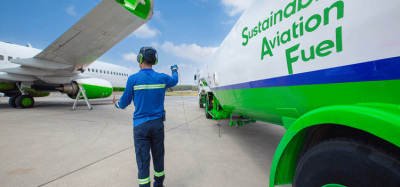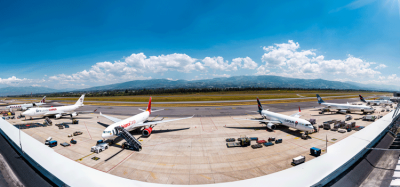Stronger together: the community of airports forging industry partnerships
- Like
- Digg
- Del
- Tumblr
- VKontakte
- Buffer
- Love This
- Odnoklassniki
- Meneame
- Blogger
- Amazon
- Yahoo Mail
- Gmail
- AOL
- Newsvine
- HackerNews
- Evernote
- MySpace
- Mail.ru
- Viadeo
- Line
- Comments
- Yummly
- SMS
- Viber
- Telegram
- Subscribe
- Skype
- Facebook Messenger
- Kakao
- LiveJournal
- Yammer
- Edgar
- Fintel
- Mix
- Instapaper
- Copy Link
Posted: 28 May 2014 | The Airports Council International | No comments yet
The Airports Council International Asia-Pacific/World Annual General Assembly 2014 concluded in Seoul, Korea after three successful days that included a robust conference programme…


The Airports Council International (ACI) Asia-Pacific/World Annual General Assembly (WAGA) 2014 concluded today in Seoul, Korea after three successful days that included a robust conference programme; a fully subscribed Safety Symposium; an at-capacity World Human Resources Forum; a lively exhibition; and ample networking opportunities at a variety of social events. Graciously hosted by Incheon International Airport, this year’s event set a record for the highest number of attendees at any WAGA outside of North America, underscoring its importance as the premier event of the calendar year for worldwide airports.
During the Annual General Assembly today, Director General of ACI World Angela Gittens noted the importance of this year’s theme, “Airports: Serving the customer and the community,” to the continued growth of airports specifically and the aviation industry in general. She noted that to achieve our collective goals, collaboration among industry stakeholders is key.
“Collaboration extends our reach and makes more progress possible,” Gittens said. “We are stronger together, but we would not be seen as valuable allies if we were not seen as capable of providing solutions—if we were not seen as having high standards and were not committed to achieving them. This is where the community of airports—the promotion of excellence—comes to the fore. A big advantage that we have as airport operators is the willingness to help each other, even in this era of more competition. We know that weakness anywhere hurts our system and ultimately hurts each of us.”
Gittens framed her discussion with an update on the state of the industry. In spite of worldwide economic uncertainty and political instability in many countries in 2013, airports accommodated over 6 billion passengers, with both passenger and cargo traffic growing at faster rates than the previous year, indicating signs of a subdued recovery. Passenger traffic grew at 4.8% versus 4.4% in 2012 and cargo, although still sluggish, nearly hit the 1% growth mark, at 0.9% versus 0.5% in 2012. Movements, on the other hand, grew at practically the same rate as the previous year at 0.7%.
“The Middle East and Asia took the lead in both passenger and cargo growth,” Gittens explained. “Although Asia-Pacific only grew 2.1% in cargo, it managed to pull the rest of the world into positive territory due to the fact that it handles 38% of the world’s total cargo throughput.”
The industry as a whole was profitable in 2013, posting a net profit margin of 13%. Nonetheless, industry profitability is primarily generated from the 20% of airports that carry the bulk of passenger traffic. In fact, 67% of airports globally operate at a net loss and 80% of airports with fewer than a million passengers posted an average net loss of 6%. Furthermore, airports with fewer than one million passengers had a return on invested capital of -1.1%.
Gittens then went on to outline the considerable advancements that ACI has made on behalf of airports over the past year:
A corner has been turned in ICAO relations
“At the ICAO Triennial Assembly, which was held in October of last year, ACI members and staff from all Regions contributed their time and expertise on the Working Groups, Panels and Conferences that constitute the ICAO policy-development process,” Gittens explained.
ACI has become a valued industry collaborator
“Other industry players increasingly see airports and ACI as valued collaborators,” Gittens said. “This philosophy culminated in our first-ever Memorandum of Understanding with the International Air Transport Association [IATA] last October. The MoU is followed by annexes in which ACI and IATA have agreed to work on specific activities, including cooperation on ground handling best practices; automated border control; improvement of existing passenger security processes; and the joint Smart Security initiative.”
Safety remains the top priority
“ACI has embraced the direct, hands-on approach embodied in the Airport Excellence [APEX] in Safety programme,” Gittens told attendees. “We have had airports go on to achieve certification after having had an APEX in Safety peer review. We have also had airports that are already certified request peer reviews on their journey of continuous improvement. It is a programme for all airports in all parts of the world.”
The importance of a sound environmental track record
“The ACI Europe Airport Carbon Accreditation programme now reaches three regions and covers 21% of worldwide passenger traffic and 76% of European passenger traffic,” Gittens said. “We can expect that the programme will ultimately be available in every region. We also hope to get data from the users of the Airport Carbon and Emissions Reporting Tool (ACERT), the Transport Canada-developed programme designed for smaller airports that can also serve as an entry level to the Carbon Accreditation programme.”
The ASQ programme continues a strong tradition
“ACI has selected a new service provider to operate the programme starting in 2015 and we have established an ASQ Programme Steering Group so that the programme stays in better touch with member needs as they evolve,” Gittens explained. “Passenger Service benchmarking is our longest-running programme, spanning ten years of objective customer service evaluation.”
A focus on knowledge sharing
“Our training programme goes from strength to strength, and we now have 14 training centers; last year we delivered 124 classroom courses with over 2,000 students and nearly 12,000 hours of online coursework,” Gittens said. “Eight new courses were launched to meet a range of training needs for airports large and small, and we have increased our language capabilities.”
ACI Board approves resolutions conceived to help move the industry forward
Related to the above areas of concentration, the ACI Board of Directors approved resolutions related to continued cooperation with industry stakeholders; affirming the commitment to safety as airports’ top priority; the importance of promoting diversity to meet the demand for the next generation of airport professionals; the public affirmation of the community of airports concept and the airport industry’s commitment to help all airports achieve high standards of safety, security and sustainability; and ACI’s continuing provision of the data needed to assist airports in meeting and exceeding passenger expectations.
Looking ahead to WAGA 2015
The Annual General Assembly closed with the Hand-over and Closing Ceremony. ACI World Chair and CEO of Sarasota Manatee Airport Authority, Rick Piccolo, thanked Tocumen International Airport for its gracious offer to host WAGA 2015 in Panama from 31 August–2 September.

















